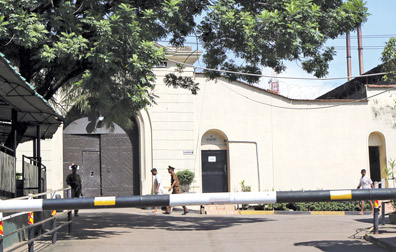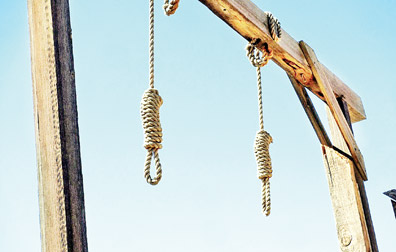7 days to live
A closer look at how the death sentence was executed
at the Welikada gallows:
by Dishan Joseph
The entire nation has raised a relentless cry for justice, via the
implementation of the death penalty by hanging.
Hanging was one of many forms of punishment used by many
civilizations, before being replaced by the electric chair and the
lethal injection. In Britain - during the 1700s - there were 222 crimes
punishable by death. The death penalty is presently active in 36
countries including China, India and the United States.
The Welikada Prison, established in 1841, is the largest prison in
the island. A maximum security prison built by British Governor Cameron,
today it is administered by B. R. Pushpakumara, the present Commissioner
General of Prisons, who is a senior SLAS officer counting over 20 years
of public service.
|

B. R. Pushpakumara, Commissioner General of Prisons
Pic: Thilak Perera |
Recalling the history of hanging persons as a severe form of
punishment in Ceylon, he says it was in 1802 that it was established as
a practice. The first person to be hung was Ingiriya Kalu Appuwa in
1812.
The execution was done in a public place in Peliyagoda, to instill
fear amongst the people. Subsequently, the first gallows were
constructed at Welikada in 1871.
As the Department grew, another gallows was set up at the Bogambara
Prison, in the salubrious hills of Kandy. The first inmate to be
executed there was T. Jayaratne, who was convicted of murdering a
teacher in Tissamada.
In 1976, the then government decided to stop the death penalty and
the last person hanged at Welikada was J.M.Chandrasena alias Honda
Papuwa.
92 hanged
Commissioner General Pushpakumara said during the year 1915, there
had been a record number of executions at Welikada. The weary
executioners worked many hours as 92 prisoners were condemned and
hanged.
According to Assistant Superintendent of the Welikada Prison
Headquarters, Kithsiri Seneviratne, a veteran counting 30 years of
service, there are 1,116 condemned and confined to the death row cells.
The condemned include six women inmates. A majority of these criminals
are housed in the infamous Chapel Ward.
Maru Sira
The misogynist lustful killer Konde Ajith responsible for the
sadistic rape and murder at Crow Island, Colombo 15 is also here.
Ironically, the Chapel Ward derives its name from a similar British Jail
building, as it takes the form of a Cross. Two notorious men
incarcerated here were Jayathungalage Siripala alias Maru Siraa, a
hardcore criminal who made three daring escapes from jail prior to his
execution and the murderous conspirator Somarama, who assassinated Prime
Minister S.W.R.D Bandaranaike.
|

Welikada Prison entrance
Pic: Thilak Perera |
Execution by hanging includes a detailed and long process, carried
out by very experienced officers. According to ASP Seneviratne, the
process begins with the inmate being escorted to courts by two jailors.
The procedure
Incidentally, months later, these same jailors must identify and
prepare the inmate for his/her final journey into the darkest abyss.
Once the verdict is handed down, the prisoner is escorted back to
Welikada (the gallows at Bogambara are now non - existent) and moved to
a maximum security cell. Here the inmates are carefully monitored
throughout the day. Prison officers keep watch, seated in the corridor
of the special block. These guards rotate on six hour shifts.
One must have a mature temperament and nerves of steel to work in
such close quarters, among the most dreaded persons of this soil,
officials say.
Once the head of state signs the Warrant, the condemned man or woman
is next taken to a holding cell, from where he can see the ghostly
gallows, beckoning him. Seven days prior to the exact date of the
execution, the inmate is moved into one solitary cell and moved into a
new cell each day (during the final seven days).
Final request
As per the Prison Ordinance, the inmate can make some final requests
and air a few cherished desires. Close family members are allowed to
visit the inmate. The condemned is also served one dram of wine each
day. It is also possible to smoke three cigarettes or beedis daily. This
is supplemented by fresh hoppers, three bundles of betel leaves and tea.
By contrast, convicted killers in the US are able to order steaks,
shrimp and chocolate chip ice cream!
On day number seven, the executioner, the somewhat ostracized
choreographer of death is brought into the Welikada Prison and begins a
meticulous process of getting the gallows into operational position. A
guard is placed 24 hours at the site where the execution is to be
carried out. An overwhelming stillness invades the prison.
Long Drop
The method used in Sri Lanka, known as the Long Drop method of
hanging a prisoner was first devised by William Marwood of Britain in
1872.
The robust executioner must weigh the inmate, as per the Table of
Drop and then has to fill a sack with sand, to the exact weight. Next,
several practice runs are made to ensure a smooth execution.
|

Pic: Internet |
In Sri Lanka, the inmate is suspended by a sturdy rope and stands on
a trap door. When the lever is released with one precision jerk, the
trap door gives way to instant death.
Religious rites
By tradition, all executions are carried out at 7 a.m. At 8 a.m, the
inmate has access to final religious rites and prayers within the walls
of the C- Ward.
He is then dressed in white attire, complete with a hood that covers
his full face. Physical movement of the hands is further restrained by a
body belt.
He is thereafter carefully escorted out of his holding cell by the
two executioners and positioned on the 'stage' where, as a final
security measure, his feet are fastened by an ankle strap.
This is done to prevent the movement of feet and making any attempt
to bypass the trapdoor as it gives way. The noose rests securely on the
condemned person's neck. One executioner double checks the resistance of
the knot. The other takes his place by the lever.
Meanwhile, the Superintendent of Prisons and the Prison Medical
Officer stand as witnesses. On the morning of the execution, the
customary bell that heralds other inmates to work is not rung. The eerie
silence is almost deafening. Once all this is in place, the final order
is given.
Two human hands rapidly take away one human life. The Prison Medical
Officer will carry out his duties confirming that the condemned prisoner
has paid the price for the crime committed. The body is next dispatched
to the Judicial Medical Officer (JMO).
As per the Prison Ordinance, the body must be buried within 24 hours,
but at times, is handed over to the family, on request. The executioner
having performed his duty is now free to return home.
Interviews
Commissioner General Pushpakumara said interviews have been
successfully conducted to fill the vacancies for two executioners with
aspiring applicants aged between 19 to 40 years of age. The two selected
persons, appointed last Friday (15) will undergo training for three
weeks.
Whenever this nation is ready to implement the death penalty, the
dedicated officers at Welikada Prison will be primed and ready for the
task.
While death is the final exit to human existence, it apt to be
reminded of Mahatma Gandhi's words that 'A person's conscience is the
highest court.' |

